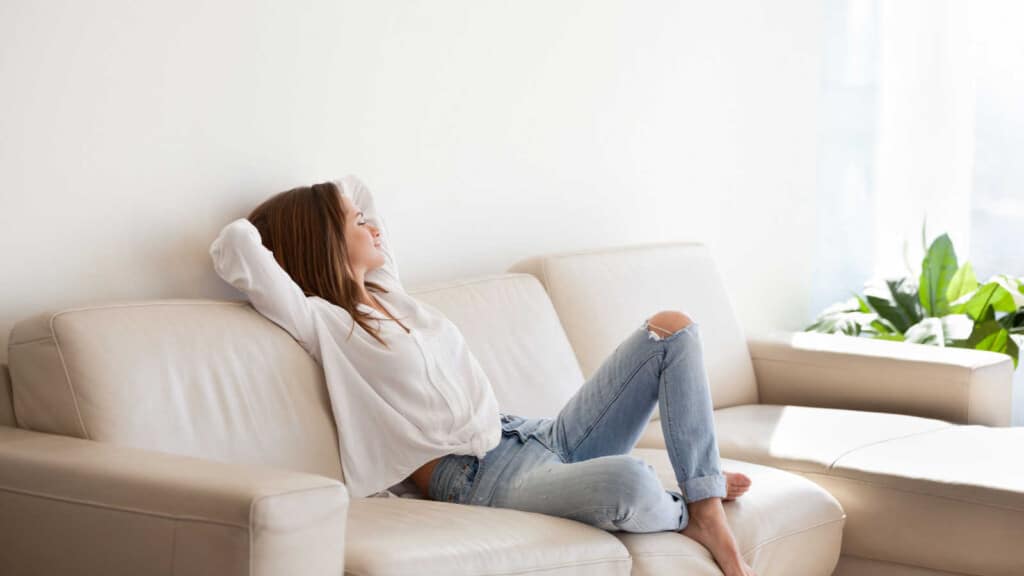Discovering those dreaded fuzzy mold and mildew spots growing on your fabric sofa can be worrying and off-putting. But banishing mold from your upholstered furniture is very doable using straightforward cleaning techniques and moisture control. Stopping mold in its tracks and preventing recurrence is all about denying it the damp conditions that allow it to spread. Follow these tips to fully remove mold from fabric sofas and keep it away for good.

Act Quickly at the First Signs of Mold
Regularly inspect the surfaces and undersides of sofa cushions to catch small mold spots early before they multiply and expand. At the very first signs of mold growth – usually black, green or orange speckles or powdery buildup – take action to treat it promptly.
Mix up a natural cleaning solution of one part distilled white vinegar to one part water in a spray bottle. Liberally spritz the affected area of upholstery to fully saturate the moldy patch. Allow the solution to sit for about 10 minutes before blotting it away with a clean absorbent cloth. The vinegar helps kill mold spores and lift stains.
Limit Overall Moisture Exposure
To prevent mold growth in the first place, it’s essential to limit moisture reaching and accumulating on your sofa’s fabric. Avoid placing upholstered furniture directly against poorly insulated exterior walls or basement foundations where condensation readily collects, creating prime mold conditions.
Manage household humidity levels by running air conditioners and dehumidifiers, especially in damp basements. Immediately dry out and air any cushions or fabric that get wet from spills, pets or leaks before mold takes hold.

Increase Air Circulation Around and Under Furniture
Stagnant air and darkness help mold thrive, so ensure good airflow circulation around and underneath your upholstered sofa. Open windows regularly to bring in fresh drying breezes. Don’t overcrowd furniture, allowing ample space for air to flow between pieces.
Rotate and flip cushions periodically so all upholstery surfaces get equal air exposure. Consider using circulating fans or even a small dehumidifier to keep humidity down.
Use Baking Soda to Lift Mold Stains
For treating larger or more stubborn upholstery mold spots and stains where vinegar alone doesn’t suffice, baking soda can help lift and absorb the mold residue. Generously sprinkle baking soda directly onto affected areas, massaging it deep into the fibers with a soft brush for full coverage.
Let the baking soda sit for at least 15-30 minutes to allow moisture and stain-trapping action before thoroughly vacuuming the area to remove all powder. The microscopic baking soda granules work to pull out and absorb the mold and musty odors from deep within the fibers.
Disinfect with a Borax Solution
To thoroughly disinfect a sofa with mold while removing stains and musty odors, a borax solution is highly effective. Dissolve 1/2 cup borax powder per every gallon of very hot water. Use a sponge to liberally apply the solution over affected upholstery areas. Allow it to penetrate for at least an hour.
Gently blot with clean absorbent rags until dry. The alkaline borax inhibits further mold growth while eliminating tough odors and lifting set-in stains. Just take care to thoroughly rinse any solution from leather or vinyl upholstery to avoid damage.
Foster a Mold-Resistant Fabric Sofa
Spotting and promptly treating mold keeps it from spreading across your sofa’s fabric long-term. Equally important is addressing the underlying moisture issue fueling mold’s growth. With vigilant maintenance and moisture control, you can halt mold in its tracks and enjoy mold-free upholstery for years to come.
